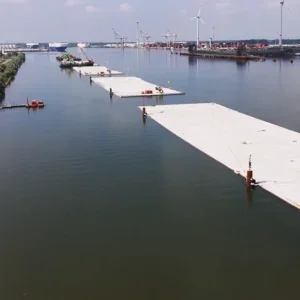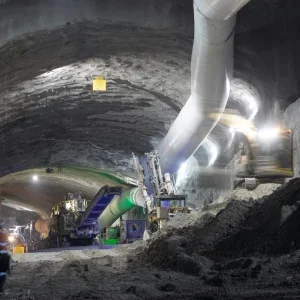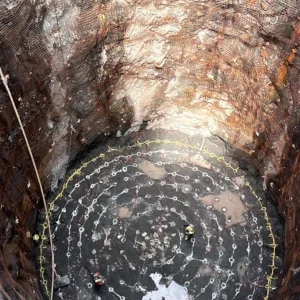Most rock mass classification schemes fall short in meeting the demands of increasingly complex contractual conditions for today’s infrastructure projects, where cost and risk control play a major role. The concept for rock mass characterisation proposed in this paper systematically aims towards the definition of typical rock mass behaviour and the recognition and description of geotechnical risks. The product is the definition of rock mass types that supply the information required for tunnel design as well as for ground-related contractual issues.
Geotechnical risks in tunnelling
Geotechnical risks in tunnelling generally stand for hazardous geotechnical conditions, which could unfavourably affect a tunnel project and might – in the worst case – cause fatalities. Less tragic but also significant consequences include damage to equipment, interruption of works, inadequacy of design, contractual claims, etc. all of which eventually lead to delays to schedule and/or increase of project costs.
Most geotechnical risks can be controlled by adequate design solutions that prevent the occurrence of the “risk event” (e.g. modification of tunnel alignment to avoid intersection of major fault zone), or minimise the consequences of a “risk event”.
Some geotechnical risks cannot be controlled by economically and/or technically feasible design solutions. The consequences of such a risk event (e.g. catastrophic earthquake) must be assessed and considered in the project risk management plan.
The precondition for risk control and risk management is the timely recognition of potential geotechnical risks for a project. A considerable amount of significant geotechnical risk factors reflect specific rather than standard conditions (e.g. extremely weak materials along fault zones, or karstic fault breccias). Frequently overlooked in the course of the feasibility study and the design stages are unforeseen non-standard conditions which often give rise to the most significant hazards, damages and/or contractual disagreements.
Most geotechnical risks in tunnelling are directly related to the properties of the rock mass and to circumstantial influencing factors such as insitu stress, kinematics, groundwater, orientation and dimensions of excavation. The interaction of rock mass properties and influencing factors eventually defines the rock mass behaviour that would be observed during tunnel excavation without application of support/construction measures. Though such a situation does not reflect typical conditions during construction works, the description of rock mass behaviour without support is required for the basic understanding of potential failure modes and risk events.
The actual scenario during and after construction can be referred to as “system behaviour”(11), (16) that relates to deformations and conditions taking place during excavation and after application of routine support measures (Figure 1). A specific rock mass behaviour or singular hazardous event that cannot reasonably be controlled by available routine support measures or standard design would lead to unsafe system behaviour, posing a geotechnical risk.
Ideally, all potential risks related to rock mass characteristics should be covered by a rock mass classification system that provides the conclusive summary of geological/geotechnical conditions expected during tunnelling.
Rock mass classification
Rock mass properties, including lithological, structural and rock mechanical characteristics and selected circumstantial factors (e.g. groundwater, overburden) are used in standard classification schemes. These standard schemes allow for the description of typical rock mass materials (see Figure 1) that relates directly to tunnel support measures (e.g. Q(1), (2) or RMR(2)) and/or supports the assessment of rock mass parameters (e.g. GSI(5), (7)). Yielding a numerical rating or index, the quoted classification schemes are referred to as quantitative methods. In fact, reference to “semi-quantitative” scheme would be more accurate, since the classification is based on quantitative parameters (e.g. strength, RQD, spacing and set number of discontinuities) as well as qualitative parameters that are assigned to numerical values (e.g. conditions of discontinuity surfaces, rock mass structure).
The advantages of such schemes are evidently: 1) Their international application and acceptance; 2) The relative simplicity and clarity of their application; and 3) The reproducibility of classification procedures. Most of these standard schemes were originally developed for jointed rock mass and reach the limits of their applicability in soil-like materials that often prevail in very poor rock mass (e.g. some fault materials).
Quantitative classification schemes usually lack a qualitative description of rock mass behaviour. The consideration of direct interaction between rock mass classes, support classes and deformation measurements during excavation is not foreseen. This may lead either to over-conservative and costly support application, or to the under-estimation of specific hazardous conditions.
In contrast to these quantitative approaches, classification schemes that have been routinely applied in the Eastern Alps (e.g. Austrian standard ÖNORM B 2203(12)) were based largely on the qualitative description of rock mass behaviour(3), (9), (10), (12). The advantages include: 1) Rock mass classes are defined in relation to typical deformation and behaviour modes; 2) The adequacy of the classification and applied support can directly be verified by deformation measurements during tunnel excavation (Figure 1) allowing for a flexible and cost efficient project realisation; 3) The classification scheme is also functional in very poor, soil-like ground where the description of discontinuities in jointed rock mass is less relevant and standard quantitative classification systems (see above) reach the limits of their applicability. A safe and efficient performance of rock mass classification according to this approach, though, requires profound understanding of geo-mechanical aspects of rock mass behaviour, failure modes and their relation to rock mass characteristics. Because of this prerequisite and the lack of quantitative definitions, the method – though successfully applied in projects worldwide – proved to be internationally less accepted than quantitative classification schemes.
All of the above described rock mass classification schemes fall short – in one way or another – in meeting the demands of increasingly complex contractual conditions for today’s infrastructure projects, where cost and risk control plays a major role.
Adequate ground classification is not only an indispensable tool for tunnel design but also forms a basic part of construction contracts. The lack of adequate ground classification is frequently the main cause for contractual disagreements. A classification scheme that allows the assessment of reasonably foreseeable geotechnical risks protects the client from unjustified claims, and allows the contractor to request compensation for unforeseeable conditions, both according to international contract regulations or recommendations on risk sharing (e.g. FIDIC(4), ITA(8)).
For satisfying these requirements, a rock mass classification scheme must:
New methods and the modification of available standards contributed to the development of rock mass classification throughout the last decade, providing more sophisticated classification tools that take into account contractual as well as technical aspects. Quantitative and qualitative rock mass classification methods were combined in projects worldwide to comply with specific requirements.
The original qualitative classification approach(12) was modified by enhancing the input of quantitative data and by increasing the transparency of classification procedures and terminology. The methodology was standardised in official guidelines in 2001(11), (16) that supplement the new Austrian Standard for cyclic underground excavation (ÖNORM B 2203-1(13)).
Proposed concept
The concept proposed here combines quantitative and qualitative classification methods (Figure 2). It systematically aims towards the definition of typical rock mass behaviour patterns and towards the recognition and description of geotechnical risks (Figure 3).
The characterisation process permits the definition of “rock mass types” (RMTs*) that display typical deformation/failure patterns and/or may impose specific geotechnical hazards. The number of rock mass types individually defined for a project depends on project-specific conditions (such as the complexity of geological conditions, or the variety of potential failure modes and risks). Also because of this inherent and unusual flexibility the concept provides a tool that can handle technical and contractual aspects of non-standard geotechnical conditions with increasing efficiency for all involved parties.
Rock mass descriptions and the assessment of rock mass behaviour, failure modes and risks are based on factual site investigation data, field observations, kinematic (e.g. Unwedge), numerical (e.g. FLAC) or analytical analysis(6). Design parameters are derived from statistically evaluated factual data and/or are estimated according to internationally accepted procedures (e.g. Hoek & Brown criterion(5), (7) Roclab(15)). Quantitative standard classifications (e.g. GSI, Q, RMR) are implemented, depending on project specifics and client’s requirements.
Factual and interpretative, quantitative and qualitative key data are summarised in a single classification sheet for each rock mass type (RMT). Thus, typical rock mass behaviour and geotechnical risks related to non-standard events, issues that are often concealed in text parts of geotechnical reports if mentioned at all, are placed prominently in geotechnical reporting.
The geotechnical risks identified and described in the classification sheets should be considered for quantitative risk analysis, development of special design/support/construction measures, construction scheduling and the development of a project risk management plan.
Summary and conclusions
The concept for rock mass characterisation proposed in this paper combines quantitative and qualitative rock mass classification systems. The process can be individually adjusted by employing a variety of methods. Key elements including rock and rock mass properties, circumstantial influencing factors, geomechanical parameters, typical rock mass behaviour, failure modes and geotechnical risks are described in a classification sheet for individual rock mass types that are correlated to quantitative standard classification systems.
All descriptions and assessments are performed to international and/or national standards/methods, allowing for transparent and reproducible classification. The scheme systematically aims towards the definition of typical rock mass behaviour and the recognition and description of geotechnical risks. The product is the definition of rock mass types (RMTs) that supply the conclusive information required for tunnel design as well as for ground-related contractual issues.
Related Files
Fig 2 – Proposed rock mass characterisation in the frame of ground conditions and tunnel design
Fig 1 – Schematic relations between rock mass properties, rock mass behaviour and support design with quantitative and qualitative classification approaches
Fig 3 – Proposed rock mass characterisation – classification process







